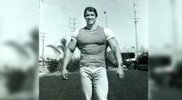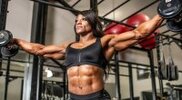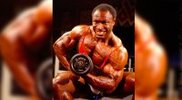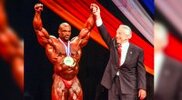V
vkim
Guest
In the long history of bodybuilding tradition bodybuilders trained like weightlifters. They were weightlifters or strongmen who lifted weights and who began over time to be as concerned about what they looked like instead of or in addition to how much they could lift.
This trend accelerated in the 1930s with the advent of “Physical Culture” contests in which athletes with obvious aesthetic muscularity from weight training had a distinct advantage in physical development. These events involved things like some kind of athletic performance and sometimes public speaking, but by 1939 the emphasis shifted to focus on judging muscular development as the competitors flexed and then did a personal posing routine – in other words, bodybuilding as we know it today.
Some bodybuilders in the 1940s still did things like gymnastics and the kind of hand-balancing you see in vintage photos of the original Muscle Beach in Santa Monica, but through the 1950s there was more emphasis on the kind of bodybuilding posing we still see today such as side chest or double-biceps shots. However, the training routines of this era remained pretty much the same: mostly working the entire body in one workout three times a week as that of a weightlifter. But gradually a more modern system evolved, using techniques that Joe Weider would codify as “The Weider System.” These included split-system training, working only part of the body in any workout; combining two-joint power exercises and one-joint isolation movements; peak contraction, supersets, and using a wide variety of different exercises for each body part.

When he first came on the scene in the 60s, Arnold had lots of muscle and in the ’70s he combined size and definition to win the Olympia Courtesy of Gene Mozee
During the 1960s, thanks to these new techniques, plus a more advanced approach to dieting (no more drinking lots of whole milk, for example), bodybuilders began to appear on stage much more muscular and defined, rather than just big and smooth. This trend continued through the 1970s until we began to see extremely ripped competitors, defined but often way too depleted (in large part to extreme dehydration and ketosis diets). But also because of overtraining.
Overtraining, as far as bodybuilding is concerned, comes from training too hard, too often, or too long and not giving muscles enough time to rest, recuperate and grow. Training stimulates the growth that doesn’t take place until you are resting and recovering. In the 60s and 70s, bodybuilders began to exercise as if the more sets and reps you did the bigger you got. As a result, we began to see very muscular and defined competitors, but not at all big compared to most pro bodybuilders today.

Ms. Olympia, Andrea Shaw demonstrates excellent form doing dumbbell side laterals. Wings Of Strength
An example would be Arnold Schwarzenegger. At over 6’ tall, Arnold as a young man weighed in something like 255 or 260 pounds. At his best in the 1970s, he was on stage weighing 235 pounds. Very small by modern standards and very small if you consider his obvious genetics for muscle. Why was this the case? If you compare the two versions of Arnold’s Encyclopedia of Modern Bodybuilding, one describing how he trained in his early years and the other his recommendations for the newer techniques that have evolved over the decades. One of the major differences is training volume and how much rest you need to avoid overtraining. He now recommends shorter sessions of high-intensity training, fewer set and reps than back in the day, and plenty of time to rest and recuperate between workouts.
Bodybuilding training should be like a series of sprints, not long-distance running. If you work out intensely enough, you quickly outpace the ability of your body to deliver fresh oxygen to the muscles. This is anaerobic activity. You feel the “burn” as lactic acid builds up in the muscles. At this point, you need to stop and rest and allow the muscle to recover. But these muscles do not fully recover in a short time. So, you are still fatigued when you do your subsequent sets for those muscles or that muscle group.
But then you need time between workouts for the body to totally recover. This varies according to the muscles worked. The biceps recover faster than any other muscle group; the lower back the slowest. Legs take more time to rest and recover than back or shoulders.
It is also a fact that in bodybuilding tradition bodybuilders continue to do more sets and exercises than necessary to develop any individual muscle or body part. For example, dealing with a simple muscle group like the biceps, all these muscles do is curl the arms – contraction from point of origin at the shoulder to point of insertion in the forearm and bend the elbow joint.
When you do biceps dumbbell or barbell curls, cable curls, machine curls, or concentration curls you are essentially doing the same movement over and over and over. There are some differences between lifting a free weight where joint stabilization is necessary and curls on a machine where it is not, the biceps are essentially contracting through the same range of motion multiple times. A couple of biceps exercises is one thing; four or five are quite different. The biceps are so comparatively small that it is easy to overtrain them with too many sets and reps.
Now, there has been an alternate approach to training popular with many. This follows the principles promoted by Arthur Jones, developer of Nautilus, and involves very “heavy-duty” and low rep workouts – including forced reps and negatives and forced negatives. If you were promoting a Nautilus gym, this resulted in members going through a circuit fairly quickly, getting off the machines and leaving room for another group of members to get their own circuits in. This allowed for a gym to increase its number of active members. But this is not the most effective and efficient method of developing a competitive bodybuilding physique.

By the time Lee Haney came along in the 1980s, there was much less overtraining in their workouts than in previous decades. Bill Dobbins
There have been bodybuilders who have claimed to have built their physiques using these principles, like Mike Mentzer and Casey Viator, but they had already created muscular physiques using the traditional method before they ever saw a Nautilus machine. Dorian Yates won multiple Mr. Olympia titles using this approach to training, but the stress tore his body apart – a penalty he was aware of but willing to pay in order to become a major champion.
So, what is the most effective and efficient way of training to build muscle? According to powerlifting champion Dr. Fred Hatfield (Dr. Squat), it involves contracting the muscle against just enough resistance for just enough reps – or “Time Under Tension.” The right amount of resistance is about 75% of your one-rep maximum. This allows you to do about 8 to 12 reps for upper body movements, lightly more for legs (better blood and oxygen delivery). You don’t really train the muscle directly; you program the nervous system. In order to send the right signals through the nervous system to create the stimulus needed to build muscle, you need to have about one minute total time under tension.

Ronnie Coleman was one of the strongest competitors, but trained as a modern bodybuilder, not like a weightlifter. Bill Dobbins
Each rep is only about a second long. So, a total of a minute TUT is achieved by the familiar three to four sets of three to four exercises per body part.
There is also the fact that contracting a muscle against resistance is what stimulates it to grow. Lowering a weight does not have the same result. It just puts a lot of stress on joints and connective tissue.
Remember, progressive resistance training can be used to create a variety of different responses in the body. Really heavy, low rep training is best for developing thick muscle and maximum strength. Using less weight and a lot of repetitions results in a small, leaner, and well-defined physique like that of a gymnast.
This can vary quite a lot depending on individual genetics. There have been some athletes who have developed a lot of muscle and muscularity (but not enough for bodybuilding) doing nothing but calisthenics. I remember being in high school when nobody was training with weights. There were some teenage classmates who were genetically big and muscular and those of us who were not. I wasn’t built for football, or I opted for baseball.
The effect that bodybuilders are looking for is big, round and well-shaped muscle and extreme muscularity. And that’s why they need to avoid over-training – not too many sets and reps, not too much weight, and plenty of time between workouts to allow the body to rest, recuperate and grow.
If you look at the progress in performance in sports in general, from tennis, golf, and baseball to track or boxing, there are two factors that have allowed this to happen. The first is the improvement in equipment. Running shoes are like springs that allow for more energy in each stride. Golf clubs and tennis rackets look very little like what they did 30 or 40 years ago.
But the most important factor is strength and conditioning techniques, which have produced athletes with much greater physical abilities than in the past. Barry Bonds may have been caught using anabolics, but he was also doing 300-pound bench presses. Tiger Woods was the first modern golfer to work hard on weight training and now all the young competitors have followed suit.
And one reason the current bodybuilders tend to be so much bigger than in the past is they have learned to train more efficiently and economically, in a way that creates maximum stimulation for muscle growth and allows for all the time necessary to rest, recuperate and grow.

Training
Here's what has changed, and what has been learned.
Read article
Continue reading...
This trend accelerated in the 1930s with the advent of “Physical Culture” contests in which athletes with obvious aesthetic muscularity from weight training had a distinct advantage in physical development. These events involved things like some kind of athletic performance and sometimes public speaking, but by 1939 the emphasis shifted to focus on judging muscular development as the competitors flexed and then did a personal posing routine – in other words, bodybuilding as we know it today.
Some bodybuilders in the 1940s still did things like gymnastics and the kind of hand-balancing you see in vintage photos of the original Muscle Beach in Santa Monica, but through the 1950s there was more emphasis on the kind of bodybuilding posing we still see today such as side chest or double-biceps shots. However, the training routines of this era remained pretty much the same: mostly working the entire body in one workout three times a week as that of a weightlifter. But gradually a more modern system evolved, using techniques that Joe Weider would codify as “The Weider System.” These included split-system training, working only part of the body in any workout; combining two-joint power exercises and one-joint isolation movements; peak contraction, supersets, and using a wide variety of different exercises for each body part.

When he first came on the scene in the 60s, Arnold had lots of muscle and in the ’70s he combined size and definition to win the Olympia Courtesy of Gene Mozee
During the 1960s, thanks to these new techniques, plus a more advanced approach to dieting (no more drinking lots of whole milk, for example), bodybuilders began to appear on stage much more muscular and defined, rather than just big and smooth. This trend continued through the 1970s until we began to see extremely ripped competitors, defined but often way too depleted (in large part to extreme dehydration and ketosis diets). But also because of overtraining.
Overtraining, as far as bodybuilding is concerned, comes from training too hard, too often, or too long and not giving muscles enough time to rest, recuperate and grow. Training stimulates the growth that doesn’t take place until you are resting and recovering. In the 60s and 70s, bodybuilders began to exercise as if the more sets and reps you did the bigger you got. As a result, we began to see very muscular and defined competitors, but not at all big compared to most pro bodybuilders today.

Ms. Olympia, Andrea Shaw demonstrates excellent form doing dumbbell side laterals. Wings Of Strength
An example would be Arnold Schwarzenegger. At over 6’ tall, Arnold as a young man weighed in something like 255 or 260 pounds. At his best in the 1970s, he was on stage weighing 235 pounds. Very small by modern standards and very small if you consider his obvious genetics for muscle. Why was this the case? If you compare the two versions of Arnold’s Encyclopedia of Modern Bodybuilding, one describing how he trained in his early years and the other his recommendations for the newer techniques that have evolved over the decades. One of the major differences is training volume and how much rest you need to avoid overtraining. He now recommends shorter sessions of high-intensity training, fewer set and reps than back in the day, and plenty of time to rest and recuperate between workouts.
Bodybuilding training should be like a series of sprints, not long-distance running. If you work out intensely enough, you quickly outpace the ability of your body to deliver fresh oxygen to the muscles. This is anaerobic activity. You feel the “burn” as lactic acid builds up in the muscles. At this point, you need to stop and rest and allow the muscle to recover. But these muscles do not fully recover in a short time. So, you are still fatigued when you do your subsequent sets for those muscles or that muscle group.
But then you need time between workouts for the body to totally recover. This varies according to the muscles worked. The biceps recover faster than any other muscle group; the lower back the slowest. Legs take more time to rest and recover than back or shoulders.
It is also a fact that in bodybuilding tradition bodybuilders continue to do more sets and exercises than necessary to develop any individual muscle or body part. For example, dealing with a simple muscle group like the biceps, all these muscles do is curl the arms – contraction from point of origin at the shoulder to point of insertion in the forearm and bend the elbow joint.
When you do biceps dumbbell or barbell curls, cable curls, machine curls, or concentration curls you are essentially doing the same movement over and over and over. There are some differences between lifting a free weight where joint stabilization is necessary and curls on a machine where it is not, the biceps are essentially contracting through the same range of motion multiple times. A couple of biceps exercises is one thing; four or five are quite different. The biceps are so comparatively small that it is easy to overtrain them with too many sets and reps.
Now, there has been an alternate approach to training popular with many. This follows the principles promoted by Arthur Jones, developer of Nautilus, and involves very “heavy-duty” and low rep workouts – including forced reps and negatives and forced negatives. If you were promoting a Nautilus gym, this resulted in members going through a circuit fairly quickly, getting off the machines and leaving room for another group of members to get their own circuits in. This allowed for a gym to increase its number of active members. But this is not the most effective and efficient method of developing a competitive bodybuilding physique.

By the time Lee Haney came along in the 1980s, there was much less overtraining in their workouts than in previous decades. Bill Dobbins
There have been bodybuilders who have claimed to have built their physiques using these principles, like Mike Mentzer and Casey Viator, but they had already created muscular physiques using the traditional method before they ever saw a Nautilus machine. Dorian Yates won multiple Mr. Olympia titles using this approach to training, but the stress tore his body apart – a penalty he was aware of but willing to pay in order to become a major champion.
So, what is the most effective and efficient way of training to build muscle? According to powerlifting champion Dr. Fred Hatfield (Dr. Squat), it involves contracting the muscle against just enough resistance for just enough reps – or “Time Under Tension.” The right amount of resistance is about 75% of your one-rep maximum. This allows you to do about 8 to 12 reps for upper body movements, lightly more for legs (better blood and oxygen delivery). You don’t really train the muscle directly; you program the nervous system. In order to send the right signals through the nervous system to create the stimulus needed to build muscle, you need to have about one minute total time under tension.

Ronnie Coleman was one of the strongest competitors, but trained as a modern bodybuilder, not like a weightlifter. Bill Dobbins
Each rep is only about a second long. So, a total of a minute TUT is achieved by the familiar three to four sets of three to four exercises per body part.
There is also the fact that contracting a muscle against resistance is what stimulates it to grow. Lowering a weight does not have the same result. It just puts a lot of stress on joints and connective tissue.
Remember, progressive resistance training can be used to create a variety of different responses in the body. Really heavy, low rep training is best for developing thick muscle and maximum strength. Using less weight and a lot of repetitions results in a small, leaner, and well-defined physique like that of a gymnast.
This can vary quite a lot depending on individual genetics. There have been some athletes who have developed a lot of muscle and muscularity (but not enough for bodybuilding) doing nothing but calisthenics. I remember being in high school when nobody was training with weights. There were some teenage classmates who were genetically big and muscular and those of us who were not. I wasn’t built for football, or I opted for baseball.
The effect that bodybuilders are looking for is big, round and well-shaped muscle and extreme muscularity. And that’s why they need to avoid over-training – not too many sets and reps, not too much weight, and plenty of time between workouts to allow the body to rest, recuperate and grow.
If you look at the progress in performance in sports in general, from tennis, golf, and baseball to track or boxing, there are two factors that have allowed this to happen. The first is the improvement in equipment. Running shoes are like springs that allow for more energy in each stride. Golf clubs and tennis rackets look very little like what they did 30 or 40 years ago.
But the most important factor is strength and conditioning techniques, which have produced athletes with much greater physical abilities than in the past. Barry Bonds may have been caught using anabolics, but he was also doing 300-pound bench presses. Tiger Woods was the first modern golfer to work hard on weight training and now all the young competitors have followed suit.
And one reason the current bodybuilders tend to be so much bigger than in the past is they have learned to train more efficiently and economically, in a way that creates maximum stimulation for muscle growth and allows for all the time necessary to rest, recuperate and grow.

Training
Why Bodybuilders Are So Much Bigger Today
Here's what has changed, and what has been learned.
Read article
Continue reading...

